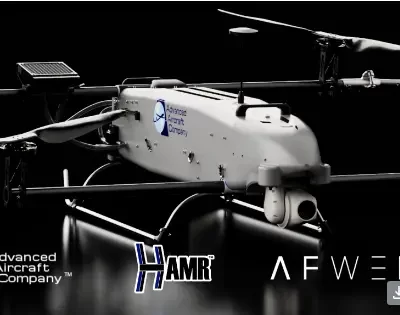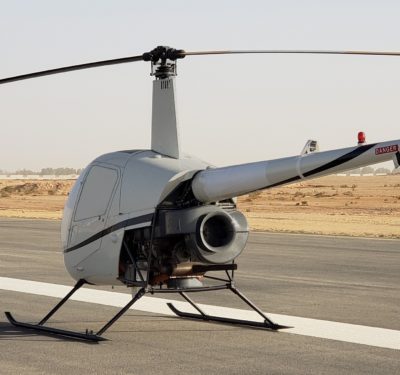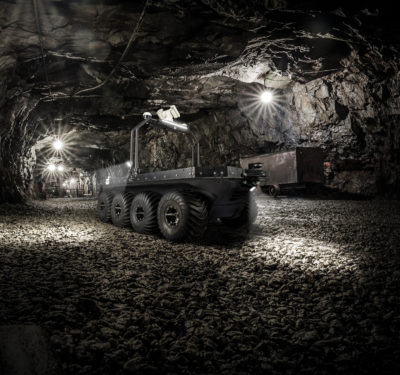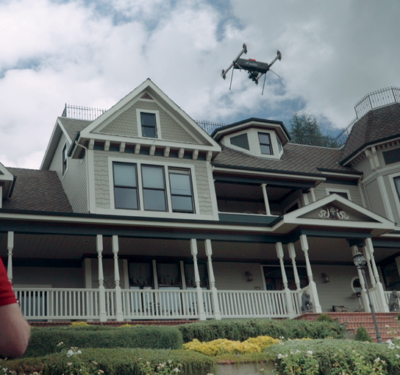“Transformer” hybrids claim benefits of ground and air platforms.
In Greek myth, the winged steed Pegasus helped the hero Bellerophon ride across the land and sky. Now, Pegasus transformable robots from Gaithersburg, Maryland-based Robotic Research can operate much the same way, as hybrid machines combining the best of both aerial and ground vehicles.

The idea for the Pegasus line came from government customers who wanted something more than either UAVs or unmanned ground vehicles (UGVs) could provide them.
“Oftentimes, they’d want to get over rubble, go over walls, go up stairs, get into tight spots or reach areas that required significant climbing, and ground robots would have a hard time there,” said James Frelk, senior vice president of Robotic Research. “But there were obvious limitations with UAVs on flight time—the capacities of batteries are limited to 30 minutes to an hour and a half.”
This led Robotic Research to design a versatile robot that could sometimes fly and sometimes drive. “Within a six-month period, we delivered the first prototype,” Frelk said. It was developed with funding from the Defense Threat Reduction Agency and the U.S. Army Armament Research Development and Engineering Center, and built without using foreign-made parts.
First unveiled in 2019, the Pegasus robots can quickly fly past obstacles that would stymie conventional UGVs. At the same time, they can drive when they do not need to fly, giving them far more endurance than conventional UAVs.
In keeping with their hybrid nature, all the Pegasus robots have four rotors, enabling vertical takeoff and landing (VTOL). They also possess a pair of tracks like tank treads for travel on the ground, which rotate up to become propeller guards during air mode to protect the rotors when flying indoors and in tight spaces.
UAV rotors are loud, easily alerting potential adversaries. In contrast, if a Pegasus robot needs to monitor a target, “it can land safely in the middle of a rooftop and sneak up to the edge on its tracks, for quiet operations,” Frelk said.
The Defense Department previously created families of throwable robots that can be tossed over obstacles. However, these are not usually very competent ground vehicles, and once thrown, there is no one on the other side to toss them back, so soldiers often need to enter dangerous areas to recover these assets. Pegasus robots, after they fly past obstacles to perform their missions, can simply fly back.
The Pegasus family currently encompasses three variants. The first to market, the mid-size Pegasus IIe, which the company refers to as the Swiss Army Knife of the family, is small enough for one person to carry and operate, and has options for intelligence, surveillance and reconnaissance operations, as well as chemical, biological, radiological and nuclear missions. “We have some operationally deployed already,” Frelk said.
The heavy-lift Pegasus III can deliver supplies such as ammunition, batteries or water. It can also carry larger 3D LiDAR systems, as well as gimbaled payloads that need a free range of motion, and laser designators to illuminate targets for laser-guided munitions. “We sometimes call it the ‘Megasus’ because it’s so much larger,” Frelk said.
The recently introduced Pegasus Mini can fold up to the size of a football and easily fit in a rucksack. It excels in confined spaces, but can also carry small payloads, such as mapping sensors. Future capabilities for the Pegasus Mini include hand launch and tube launch.
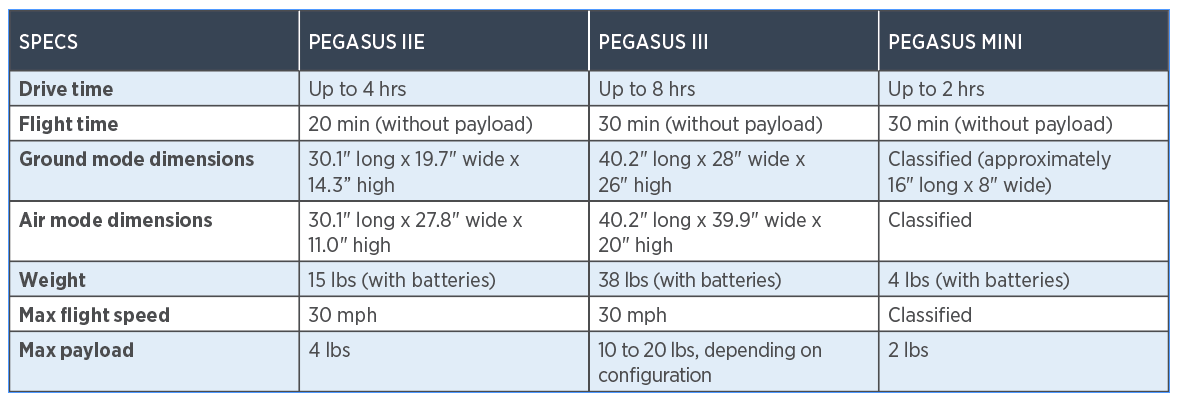
FLY OR DRIVE?
The robots are controlled by a pocket universal controller kit (PUCK), a game-style controller that works for any Pegasus model and can send autonomous missions to multiple Pegasus systems at once. It employs off-the-shelf Android phone hardware and government-owned software such as Android Team Awareness Kit (ATAK) and the U.S. Army’s Nett Warrior for its user interface.
All the Pegasus robots possess AI systems for autonomous operations in both air and ground modes, allowing them to avoid obstacles and create full 3D maps. They are all also capable of operating in GPS-denied environments, and can save data such as video, 3D maps and location information for post-processing. They can perch and stare at areas like surveillance cameras, and their batteries can help them serve as emplaced sensors for days or even weeks, only transmitting data when the cameras see motion, or at certain designated times.
The base platforms for all the Pegasus robots include electro-optical and infrared cameras and encrypted data links. They can each perform missions solo or as a part of a group that may include other Pegasus systems, manned and unmanned ground vehicles, and dismounted soldiers.
OBSTACLES AND DIRECTIONS
Designing a platform that can both fly and drive not only offers the advantages of both worlds but potentially their disadvantages as well. For instance, the weight from the ground-mode components did prove to be a challenge for the Pegasus robots’ flight capabilities.
“We addressed this with new composite structures for the leg assemblies to help improve their weight,” Frelk said. In addition, the machines can shift their components to adjust their centers of gravity, which can improve flight performance in the face of wind and boost stability while hovering.
“The Pegasus hybrids cover a set of mission sets more optimally than just a ground robot or a UAV would,” Frelk said. “They can’t lift hundreds of pounds with big arms like larger ground robots or be long-duration flyers, but that’s not the areas they address.”
Government markets for the Pegasus robots include the military and the intelligence community. “On the commercial side, they can find use in surveying and infrastructure monitoring and maintenance,” Frelk said. “There are obvious first-responder applications as well, whether SWAT teams or search and rescue.”
Future directions for the Pegasus robots include improving their autonomy and AI, especially as part of collaborative teams. “You can imagine a squad heading into a village and looking for blind spots, areas where you can’t see around a corner,” Frelk said. “We can position robotic teammates so we have eyes in all the blind spots, so at any given time, we have awareness of what we can’t see with our eyes but what our robotic teammates can see with their sensors.”
Robotic Research is also exploring other hybrid robots. “Air and water, and air and underwater—those are certainly possibilities,” Frelk said.


